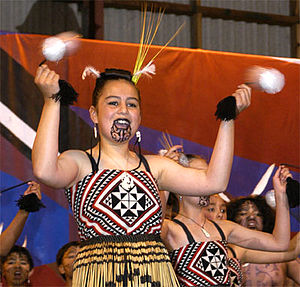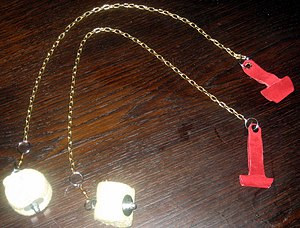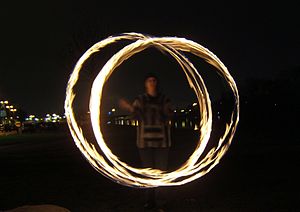Difference between revisions of "AY Honors/Māori Lore/Answer Key"
| (2 intermediate revisions by the same user not shown) | |||
| Line 74: | Line 74: | ||
This is a variation upon the leg wrap where the plane in which the poi swing before impact is altered. The lower portion of the plane is moved towards the feet, whilst the upper portion is moved away from the head. The string/chain then winds round to impact the groin region. | This is a variation upon the leg wrap where the plane in which the poi swing before impact is altered. The lower portion of the plane is moved towards the feet, whilst the upper portion is moved away from the head. The string/chain then winds round to impact the groin region. | ||
| − | + | ===Further Moves=== | |
Isolations refer to a class of moves where the poi handle is also spun in a circle. 'Perfect' isolation occurs when the poi handle and poi are moving in the same circle, and can usually create increadibly beautiful synchronised moves (eg cranks). Hyperloops (or knots) are where the poi ropes becomes entangled (twisted up) and then untangled, keeping the ends spinning the entire time. | Isolations refer to a class of moves where the poi handle is also spun in a circle. 'Perfect' isolation occurs when the poi handle and poi are moving in the same circle, and can usually create increadibly beautiful synchronised moves (eg cranks). Hyperloops (or knots) are where the poi ropes becomes entangled (twisted up) and then untangled, keeping the ends spinning the entire time. | ||
| Line 117: | Line 117: | ||
* [http://domorepoi.com/ Do More Poi] Poi Lessons, Forums, Funkiness. | * [http://domorepoi.com/ Do More Poi] Poi Lessons, Forums, Funkiness. | ||
* [http://homeofpoi.com/ Home of Poi] Forums, videos, lessons, store. | * [http://homeofpoi.com/ Home of Poi] Forums, videos, lessons, store. | ||
| + | * [http://glowsticking.com/ Glowsticking.com] Forums, videos, and tutorials specific to glowstringing. | ||
* [http://www.fire-dancing.com/fire-poi.php Fire Poi] World-wide fire poi trainers & performers. | * [http://www.fire-dancing.com/fire-poi.php Fire Poi] World-wide fire poi trainers & performers. | ||
| − | |||
* [http://www.playpoi.com/ PlayPoi] Poi website featuring videos and photos, both artistic and instructional | * [http://www.playpoi.com/ PlayPoi] Poi website featuring videos and photos, both artistic and instructional | ||
Revision as of 04:22, 21 March 2006
Poi is a form of juggling with balls on ropes, held in the hands and swung in various circular patterns, similar to club-twirling. It was originally practiced by the Māori people of New Zealand (the word poi means "ball" in Māori). Women used it as an exercise to increase flexibility of the wrists and hands, and by men to increase strength in the arms and coordination. It developed into a traditional performance art practiced mostly by women. This art in conjunction with others like waiata a ringa, haka and titi torea form the performance art of Kapa haka.
Modern poi
Today, poi extends far beyond the original Māori culture. In juggling circles, a whole subculture has sprung up in some places, surrounding poi spinning as a hobby, exercise, or performance art. Poi are considered a form of juggling, and poi dancers can often be found performing alongside jugglers, staff spinners and other similar performers.
Practice poi
Many people start out using a simple pair of practice poi. These are usually constructed from something soft, in order to lessen the chance of beginners suffering the inevitable minor bruises. Rolled up socks, bean bags or small soft toys on strings are often used. Generally, poi spinners start out with very simple moves, gradually learning to involve more complexity and (eventually) a full performance routine. Many find it helpful to practice spinning their poi to music, in order to keep a good rhythm.
Performance poi
Dancers and performers use brightly coloured poi, home made or bought at juggling shops, or a number of online stores. Fluorescent coloured tails and streamers attached to the poi allow a number of beautiful patterns to be created in the air by the performer, and many spinners pride themselves on the patterns they can make, and the accuracy of their spinning. A number of different forms of poi can be bought, from brightly coloured cones, to cloth blades that can look like dragonfly wings.
A variation on this is with 'Flag poi', consisting of large sheets of lightweight fabric which can be spun round in the same way as regular poi. Often made of reflective or UV-sensitive material, these spin quite slowly and can create the effect that the performer is wrapped in sheets of rippling fabric. The weight and drag created by these flags, however, necessitates the spinner to ensure precision of movement and timing. Consequently, they are difficult for the beginner to grasp.
Glow poi
Glow in the dark poi are available from a number of places, as can glow in the dark gloves, UV sensitive poi and poi containing LED lights that make them shine. Different types of poi can be used to create different effects, depending on the setting. Poi containing small strobes, for instance, can be used to create special effects.
By far the simplest method used is a pair of glow sticks attached to strings. Glow stick poi are popular at festivals and raves, and some brands of glow stick even come with ribbons in the packets, which many find to be ideal.
Fire poi
The "ultimate" performance poi, fire poi (or fire-twirling) are constructed from chain, with kevlar wicks that can be soaked in fuel (usually paraffin, kerosene or a similar household fuel - never petroleum) and set on fire. A fire performance is a breathtaking and exhiliarating feat for an audience and performer alike, provided the poi spinner is competent and confident enough that they can control the fire poi without putting anyone (particularly themselves) at risk.
Many kinds of fire poi are available, the simplest utilising two wicks. The fire wicks are generally one of three varieties: a cylindrical wrap, cathedral stack (square) or a monkey fist knot tied with kevlar rope. Some experienced performers like to pick and choose their wicks, according to the performance they intend to give - controlling their burn time and the brightness of the flames. More advanced fire poi can have multiple wicks.
A variation that some like to use are 'fire snakes', consisting of a length of kevlar rope that can produce a long flame. These can look stunning when used by a skilled performer, resulting in them being surrounded by sheets of brilliant flame.
Poi tricks
As with many subculture sports and pastimes, poi spinners often spend hours mastering their tricks, gaining respect from their peers for managing more impressive stunts.
Some popular poi tricks include: reels, weaves, fountains, crossovers and windmills.
The more skilled the spinner, the more impressive the tricks they can pull. Some more advanced tricks involve body wraps, which involve wrapping a poi string around an arm or leg, then pulling it to swing the poi back in the opposite direction. Split time and split direction moves are possible, and some of the more difficult moves, such as the 'five beat weave', isolation or hyperloop require a considerable amount of manual dexterity, coordination and forearm strength to accomplish.
There are several basic classes of trick. The two poi are usually spun in parallel planes, and can be spun in the same direction (weaves) or opposite directions (butterflies). Moves such as stalls and wraps can change direction of one (or both poi) to change between these two classes.
Weaves
Weaves are a class of trick based around the "basic weave".
The basic (3 beat) weave
Considered by many poi swingers to be one of the most staple moves possible, this is often one of the first tricks learned by new poi swingers. The poi are swung 180 degrees out of phase with each other, in a forward rotation. As one of the poi reaches its highest point it is swung down across the front of the body. At this point the poi that was swung across the body is at its lowest point, whilst the second poi is at its highest point on the same side of the body. The second poi is then swung across the body in a similar fassion to the way the first one was, although obviously in the opposite direction. Meanwhile the first poi is swung round to its highest point without changing side. The swingers arms are now crossed in front of their body. The first poi is swung down across the front of the body so that it is on its original side whilst the second poi is swung to its highest point. The first poi is then swung round to its highest point and the second to its lowest point without crossing sides. The first poi is then swung over the top of the opposite arm and down across the front of the body, whilst the second poi is swung back up to its highest point. The poi are now in the mirror position from when the arms where fisrt crossed. From this point the same squence from when the arms were first crossed is used, only in mirror image. The sequence can then be repeated for as long as the swinger wants.
The basic weave is three beat because each poi spins three times in a cycle. One on the same side of the body (eg left hand poi on left side) and two on the opposite side. Backwards weaves, behind the back weaves and 2,4,5 etc beat weaves are also possible (higher numbers require hyperloops)
Butterflies
Butterflies are a class of trick based around the "basic butterfly". These tricks are so named as when viewed from the front, the poi appear to be flapping horizontally like a butterflies wings.
The Basic Butterfly
The poi are swung in a forwards direction in phase with each other. The hands are then both moved in front of the swinger so that the poi traverse a circle in front of the spinner, the left poi spinning clockwise, the right poi anti-clockwise. One hand will be above the other one (typically the spinner's better hand) and their angles very slightly offset to prevent the poi from colliding as they cross at the top and bottom of their respective circles.
The Overhead Butterfly
This is a variation on the basic butterfly where as the poi swing upwards from their lowest position the hands are moved to a position above the head. As the poi swing back downwards from their highest point the hands are moved down the oppsoite side of the head to compleate the butterfly "flap". The hands are moved from the front to the back of the head alternatly with each "flap" so that the poi flap alternatly once in front of the head then once behind.
Wraps
Wraps are a class of trick in which the poi are wound around each other or a bodypart by placing it the path of the poi. These are among the most dangerous fire poi tricks as the poi can come into contact with the body or become entangled round the body.
The Leg Wrap
The leg is outstretched to the side whilst the poi are being swung to the sides of the body. The poi string or chain makes contact with the outstretched leg, causing the lower portion of the string or chain to be wound round the leg. Provided the poi had enough speed when contact with the leg was made, it will wind compleatly around the leg, with the head impacting the leg. The head will then rebound. Pulling upon the string/chain at this point will mean that, again provided there was enough initial speed, the poi compleately unwinds from the leg and swings freely in the opposite direction to the one it did initially. At this point the swinger can proceed with another trick.
The Ankle Wrap
This is a variation upon the leg wrap where instead of outstretching the leg, it is bent to 90 degrees at the knee, with the lower portion of the leg turned out to the side. The string/chain then contacts with and winds round the ankle instead of the leg. The ankle wrap is usually not caried out on both legs at once as this requires jumping, which is exceptionally difficult to carry out at the required height and speed to compleate the move before requiring to land.
The Groin Wrap
This is a variation upon the leg wrap where the plane in which the poi swing before impact is altered. The lower portion of the plane is moved towards the feet, whilst the upper portion is moved away from the head. The string/chain then winds round to impact the groin region.
Further Moves
Isolations refer to a class of moves where the poi handle is also spun in a circle. 'Perfect' isolation occurs when the poi handle and poi are moving in the same circle, and can usually create increadibly beautiful synchronised moves (eg cranks). Hyperloops (or knots) are where the poi ropes becomes entangled (twisted up) and then untangled, keeping the ends spinning the entire time.
Poi construction
Many amateur poi spinners like to create their own poi. A simple pair of practice poi require little more than a pair of socks and a couple of tennis balls. More impressive poi can be made from a multitude of different materials. Kite cords are lightweight and readily available. Chain is a more durable alternative to regular cord, ball chains can rotate freely so as to prevent tangling and metal cables can make for extremely fast poi. Long socks can also be used with a weight in one end and a knot in the other. More advanced spinners may add a weight to the handle, in order to improve their ability to perform advanced techniques (such as throws and contact poi).
Kevlar wicks and a variety of poi heads can be bought either from juggling shops, or online, and a number of different kinds of hand grip are available too. This way a performer can customise their poi to suit their own personal preference.
Following are a number of arts from different cultures that bear an affinity to poi.
Club swinging
Using regular juggling clubs, the head of the club can be held in the palm, and the club swung in poi-like patterns. Many poi moves can be attained this way, and as clubs can be stopped at any point of their swing, or swung as slowly as you like, some poi spinners find them useful in learning more difficult poi moves in 'slow motion'.
Sword spinning
Taking influence from the sword displays of the Shaolin monks, some performers learn to do tricks with swords. Swords require a lot more suppleness of the wrists, but can be far faster and more dramatic than poi performances. Practicing with bokken (japanese wooden practice swords) or simple wooden staves is advisable, but when a performer is skilled enough, fire swords can be bought and constructed. However, swords, being weapons, should be treated with respect and not taken too lightly.
Nunchaku
The osaka nunchaku, as used by Bruce Lee, employ many similar techniques to poi. While originally a weapon used to fight the Japanese, some companies now produce LED-lit nunchaku which can be used to create unique patterns in performances. Nunchaku are also weapons and should be treated as such.
Meteor
A Meteor is long rope with balls on both ends, usually a monkeyfist knot. It can be used similarly to poi as well as a staff, by keeping very precise timing so that the two balls exert equal force on each other and move in sync. Originally a chinese weapon, meteor are extremely difficult to control. Fire meteors and other variations of this tool also exist.
Safety
Depending on their construction, poi can strike the user (or bystanders) with enough force to cause bruising or minor injury.
Fire poi require a safety regime to deal with the risks of setting on fire either the user, bystanders, or the surroundings.
See also
External links
- [1] Traditional Māori poi performance
- Do More Poi Poi Lessons, Forums, Funkiness.
- Home of Poi Forums, videos, lessons, store.
- Glowsticking.com Forums, videos, and tutorials specific to glowstringing.
- Fire Poi World-wide fire poi trainers & performers.
- PlayPoi Poi website featuring videos and photos, both artistic and instructional



